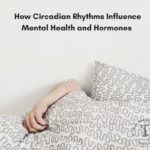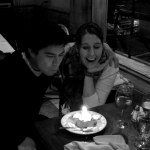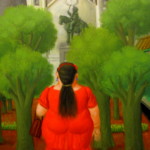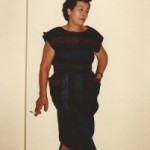This piece was meant for the CCNM Body Monologues during the 2014 Women’s Health Week. It is an important story for me to tell, so I decided to finish the final edits and publish it here.
It was in Kingston, Ontario on the campus of Queen’s University, my alma mater, where I first met my roommate, C. We were both giddy with the nervous anticipation of coming face-to-face with the person we’d sleep beside for the next year. We were like two halves of a mail-order marriage; since divorce wasn’t an option, we were determined to make it work.
The pictures we pasted on the walls of our respective sides of the room highlighted the differences in our personalities and adolescent experiences. On her wall, there were sunny photos of rows of carbon copy, bikini-clad young women, posed in a way as to accentuate their lean abdomens and disguise obtuse hips. Their skin was bronzed from the sun. They could have been models. Why weren’t they models? I’m sure some of them were models. On mine, I plastered photos of my mishmash of weird friends. We wore sideways baseball caps, looked into the camera making cartoonish Zoolander faces or tucked our necks in to parody double-chins. We held up our hands in ironic peace signs. We emphasized our ugliness in order to assure our public that we were not trying to fit in. It was hilarious.
High school for me was filled with the angst of trying to find my place in the world. In many pictures I had on Disney princess t-shirts in children’s sizes and baggy grandfather trousers from vintage clothing stores. I was trying on irony that year and, unlike my clothes, it seemed to fit quite well. Throughout my teen years, as I tried to find out who I was, I was acutely aware of my hidden longing for being the kind of girl featured en masse in C’s photos, one of which C was herself. They fit the pervasive image of what society has made clear a woman ought to look like: classically beautiful, graceful and, of course, perfectly thin. They were rewarded for their enthusiastic conformity with popularity, boyfriends and, as I saw it, peace of mind. They lined up for the same kinds of pictures that marketers use to sell us their shit. I longed for that kind of obvious beauty, of knowing my place and the guarantee of acceptance that comes with that. Instead, I struggled with chubbiness and a body that refused to look like it belonged in an American Apparel ad. It seemed like it would be so much easier to be one of the beautiful and be saved the challenge of trying to develop a persona that was funny or interesting in order to avoid spending my youth behind a grey veil of invisibility.
I was starting university at a time where women were told we could be and do anything. The school itself was 70% female, with the exception of the engineering department, which was at about a 50:50 ratio. The president of the school was a female. A photo featuring her used-car-saleswoman grin was on all the brochures. She was American and talked of privatization, which would result in increased tuition rates and lower accessibility to prospective students: go, Girl Power. Other than that, it was a grand time for women’s careers. However, it was also a grand time for eating disorders and rotten body image. Women put up their hands in class less often than male students. We spent more time on cardio machines at the gym and created long lines for the vegan section of the cafeteria where the portions were inhumanely small. The tub of low-fat ice cream at the cafeteria dessert counter was always the first one to run out. Female Queen’s students gossiped about each other and gave each other cut-eye. We all vied for the scarcity of male attention; in the anonymity of competitive academia, it served as one of the only sources of validation of self-worth. The women at Queen’s University, despite being strong in number, were tragically frail in self-esteem.
This affected me because it emphasized the importance of appearance in the art of mattering to anyone. All social interactions relied primarily on initial impressions. I fell into a dysthymia throughout my years at Queen’s and, even though C and I ended up becoming close, our differences remained and quickly became a herd of growing elephants occupying space in our tiny dorm room. She wore the proper fashions, which suited her petit frame. She garnered attention from males, sometimes unwanted but, for some reason, I failed to sympathize with that: if existing meant getting harassed, then at least she existed. I felt impossibly lonely during those four years. At the time I thought I was the only one. Such is the definition of loneliness, I suppose.
One day C found a painful lump on her shoulder. She told my roommates and me about it and we tittered back with a chorus of, “Oh, I’m sure it’s nothing”. The next week she went home. She had an appointment with her doctor for a biopsy. She didn’t come back. We got an email from her telling us that she would start chemotherapy soon; the lump was cancer. It seems that, unlike the students at Queen’s, cancer fails to notice if you’re young and beautiful.
C came back to Kingston one day to visit us. She was thinner than ever – however no one commented that this was a bad thing – and her hair was different. She took it off to reveal a bald scalp. She showed us the phone number of a guy who had sat beside her on the train and given her his number. She explained that she wouldn’t call him; she hadn’t told him she was sick. I found it amazing that she was still desirable enough to be noticed by a good-looking stranger on a train, despite the rounds of chemo she was enduring and the threat of cancerous cells invading her body. Perhaps it was because of them. Her emaciated frame made her fit in with the fashion models and the twiggy girl whose treadmill I ran beside every morning. On one occasion, the girl had fainted beside me and the campus first aid crew had to help her up and tell her to go have a juice or something to bring up her blood sugar. Sometimes I saw her walking around campus wearing clothes that still came in her size. I wondered if her body knew it was born into a first world country where grain surpluses are dumped into the ocean. She had a boyfriend. C put the wig back on.
We went out that night and I was aware of feeling fat. The fact that I was healthy in body but not in mind or spirit made me first begin to question where disease comes from. I wondered how C was feeling. What must her experience be like? I was distinctly aware of being afraid to ask. Was I afraid that her worries would put to shame my shallow, unjustifiable envy of her? Would it destroy the beauty myth I’d held on to, despite its poisonous nature? Challenging the myth might mean that I’d have to look deeper into the shadows for the source of my unhappiness, perhaps I was too afraid of what lurked there. So I remained silent.
A friend of ours noticed us, came over to say hello. She reached over and touched C’s hair, admiring it. My roommates and I burned with the hot dramatic irony of this friend’s unawareness of it being a wig. She wouldn’t find out about the cancer until months later.
I imagine that loneliness is not only reserved for those society deems inappropriate. C must have felt the loneliness too, growing in her body faster and more invasively than the cancer. If I could change something about that time I would have changed the fact that I never opened myself up to her. I never asked her how she was feeling through it all, or if she was scared to die; I wondered if she had thought about death and considered her delicately thin mortality. Those that knew her denied it being a possibility and then, a little over a year later, it turned out to be an inevitability. I wonder if the vulnerable frankness of an honest conversation would have stimulated healing in us both.
Instead, I allowed a patriarchal value system to form a gaping abyss between us, an abyss created by the lie that those who look the way they ought to live a charmed life, free from pain, that if women shut up and conform to a beauty standard then they will be happy, healthy and loved. My complacent acceptance of this lie robbed me of the ability to empathize with my friend’s suffering. I failed to consider her an equal, as the poor may be guilty of their inability to understand the suffering of the rich. And through this gaze of perceived inequality we were divided and prevented from connecting as two human beings with everything in common that mattered. We remained isolated in our respective experiences.
In both cancer and disordered eating the body fades away, rebels, is rejected and worst of all, deprived of love. Perhaps in connecting we would have felt the loneliness dissolve, looked death in the eye and refused to be invisible. It is said that those who lose their sight develop acute hearing. Our culture teaches us to be blind, so we can only respond by listening more intently to one another.







<3
Thanks for sharing!
Thanks, Janine!
Thanks so much for sharing. I have been around cancer and heart disease in my family – I never know quite how to wrap my head around it, so just take it one step at a time. Have a Great Day!
One step at a time. Always wise, Renee. Have a great day, yourself!
The 2nd most courageous thing I’ve read. And only because the 1st one is 500 p. long. Bold; emotionally and analytically.
Gracias, parce.
Tears rolling down my cheeks… So eloquent and perfectly captured! I also had a friend from university die of cancer… We also never truly spoke of her fears, fearing of course that one slip of optimism would be fatal. Well, she died last year and I wish I could have been the person she could have spoken to about it. My only hope is that she had someone else who was more courageous than I. Interestingly she also suffered for a long time prior to her illness with an eating disorder in her teen years too.
Thank you, Niki.
Beautifully written Talia
Grazie, Vanessa.